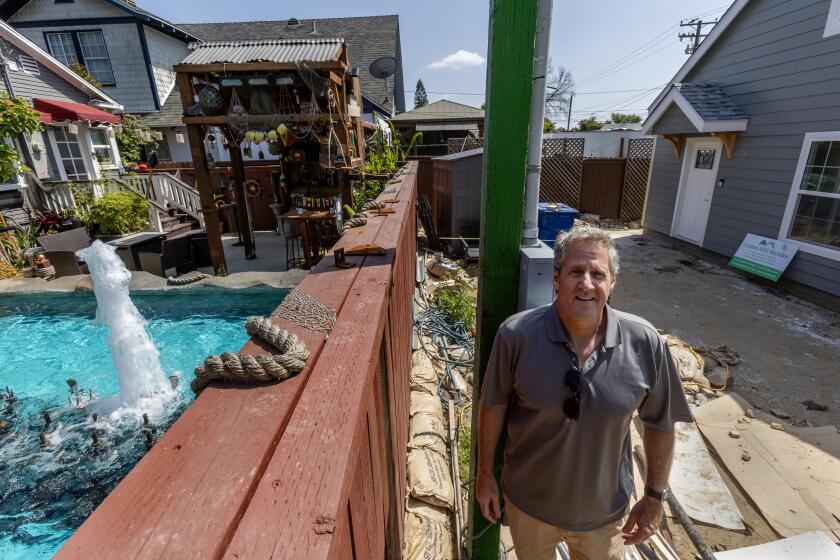Officials are still searching for the source of 4 Legionnaires’ cases. Disneyland cooling towers haven’t been ruled out

After several people in Orange County fell sick with Legionnaires’ disease in recent weeks, officials said two cooling towers at Disneyland had been linked to the outbreak.
Those towers were shut down, and officials say they no longer pose a risk to park visitors.
But a key question remains unanswered: How did four people who had not visited Disneyland become infected?
The outbreak has sickened a total of 15 people, two of whom have died. Eleven of those people visited Disneyland in September, said Orange County health agency spokeswoman Jessica Good.
The other four just lived in or had visited Anaheim, suggesting there could be sources of infection not yet discovered.
“It’s too early to point fingers at Disneyland for those four people,” said Sanjay Mohanty, a UCLA environmental engineering professor who studies water systems.
Cases of Legionnaires’ disease, a severe lung infection, have been increasing nationwide and in California in recent years, and officials often struggle to identify where the infections originate.
Where the outbreak started
Legionella is a bacteria that grows naturally in lakes and streams. Most healthy people who are exposed to it don’t get sick.
But when high concentrations of Legionella grow in man-made water systems, such as hot tubs and plumbing, some people develop pneumonia after breathing in contaminated water vapor.
Approximately 6,000 people are diagnosed with Legionnaires’ disease nationwide each year, and about 1 in 10 die from it. It is not contagious.
Cooling towers, which are part of air-conditioning systems, are often culprits in outbreaks. The towers create a warm environment in which Legionella bacteria thrive, and they release a mist that can carry the bacteria into people’s lungs.
In 2015, 16 people died and more than 100 were infected in the largest Legionnaires’ disease outbreak in New York City — one that was ultimately linked to a cooling tower.
Orange County health officials discovered last month that a number of people had been diagnosed with Legionnaires’ disease after spending time in Anaheim. They contacted Disney after learning that several had gone to the theme park.
Disney reported that two cooling towers in the park turned up elevated levels of Legionella bacteria in early October. The towers were disinfected and shut down, Disney officials said.
In a statement to The Times, Dr. Pamela Hymel, chief medical officer for Walt Disney Parks and Resorts, said health officials had informed the company that “there is no longer any known risk associated with our facilities.”
Good said health officials were visiting hotels, motels and businesses that aren’t associated with Disneyland along the busy Harbor Boulevard corridor as they continue to look into the outbreak. Though the people infected at Disneyland visited the park in September, the likely exposure dates for the other four cases range from late August through late October, she said.
“To date, no other issues have been identified and there is no known, ongoing risk,” Good said in an email.
Officials are still investigating
Daryn Cline, director of technology and science for the Alliance to Prevent Legionnaires’ Disease, said officials needed to thoroughly investigate other parts of the water supply. He said there could be elevated levels of the bacteria in water sources that feed the theme park.
“To address it with one piece of equipment off the bat is a little short-sighted,” he said.
Anaheim city spokesman Mike Lyster said officials had reviewed tests of bacteria levels in the city water supply prior to and since the outbreak and hadn’t detected any issues.
Plus, Good said the Disneyland cooling towers hadn’t been ruled out as the cause for the 15 cases. The mist they release travels into the atmosphere and can spread, she said.
"Though it will not be possible to definitely link the cases to the cooling towers, the level of contamination and their location suggests that they are a potential source for some or all cases,” she said.
UCLA’s Mohanty said that seemed unlikely. The cooling towers are in a backstage area — near the New Orleans Square Train Station — that was more than 100 feet from areas accessible to guests, according to Disney officials.
The bacteria would have had to travel even farther to infect people outside the park, Mohanty said.
“If that’s the case I would expect more people to get sick, not only four,” he said. “It’s a mystery.”
The number of Legionnaires’ cases nationwide each year is more than four times higher than it was in 2000, according to the Centers for Disease Control and Prevention.
In Orange County, more than 50 people were infected with Legionnaires’ disease last year, compared with 33 the year prior. Experts are unsure what is driving the increase.
Most people who come into contact with Legionella don’t know. People most susceptible to developing Legionnaires’ disease are those 50 and older, smokers, people with chronic lung disease or weakened immune systems or with cancer, according to the CDC.
The two people who died in the Orange County outbreak had “additional health issues,” Good said.
She said that health officials were alerting doctors and health departments about helping identify more Legionnaires’ cases among people who may have traveled to Anaheim, and particularly Disneyland.
The effort could bring forward additional cases that could provide more information about the outbreak.
So far, the majority of infected patients having visited Disneyland “indicates a pattern but does not identify that specific location as the common source of infection for all cases,” Good said. “Our investigation is ongoing.”
soumya.karlamangla@latimes.com
Twitter: @skarlamangla
ALSO
Anaheim Legionnaires' outbreak grows; 11 cases linked to Disneyland visits
San Diego's fancy $2-million public restroom raises eyebrows amid hepatitis outbreak
Online threats of violence against O.C. schools sparks fear, increased security
Orange County takes a step toward banning pot sales and distribution in unincorporated areas
Start your day right
Sign up for Essential California for news, features and recommendations from the L.A. Times and beyond in your inbox six days a week.
You may occasionally receive promotional content from the Los Angeles Times.




